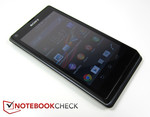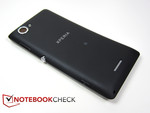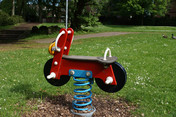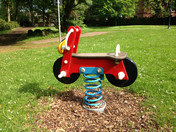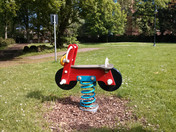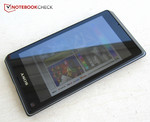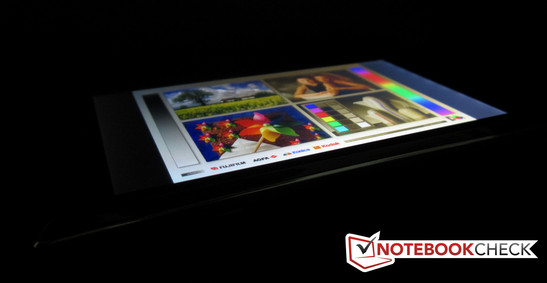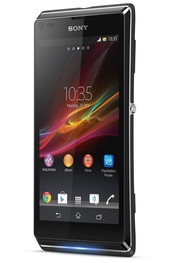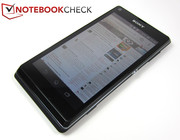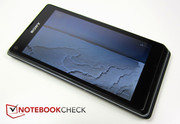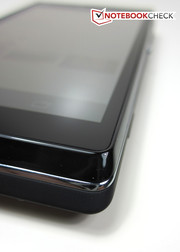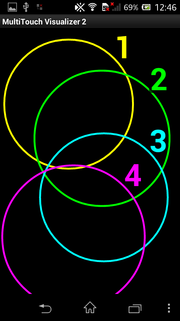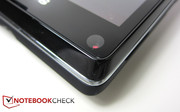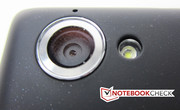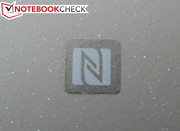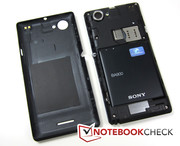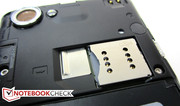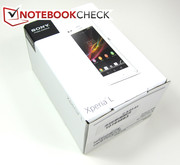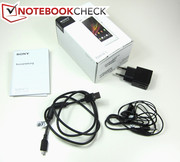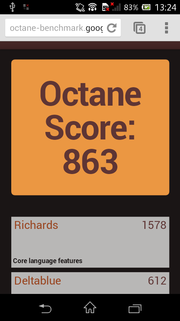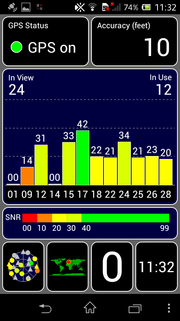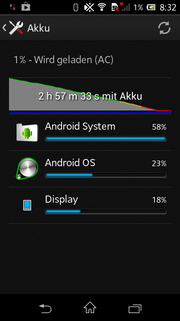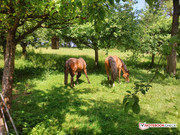Review Sony Xperia L Smartphone

For the original German review, see here.
With the Xperia Z at the top-end of the line, Sony now has a mainstream smartphone in the Xperia L. The 4.3-inch screen of our review unit is slightly smaller to the 5-inch Xperia Z and is also not as powerful. Instead of a quad core SoC, it is equipped with a dual core Qualcomm Snapdragon S4 MSM8230 processor with the integrated Qualcomm Adreno 305 GPU.
Due to its configuration, the price of the Xperia L is considerably lower than the premium Xperia Z (currently retailing around 480 Euros/~$625) at 279 Euros (~$365). For that money, you get a resolution of 854 x 480 pixels, 1 GB memory, 4 GB storage, support for all the common GSM and UMTS frequencies, an NFC module and an 8 MP camera. According to Sony, the camera is said to support HDR mode and the hardware can be an inspiration for the enthusiast to get the best out of the device.
We have a closer look at the Sony Xperia L which is available in black, white and red and show you how it performs compared to similarly equipped smartphones.
Case
One characteristic of the Xperia series is immediately visible in the Xperia L: The silver power button on the right side clearly stands out from the case. The latter is, typically for a mainstream device, made of plastic but the build quality is high and the rubberized surface provides good grip.
The 4.3-inch screen, which is made of scratch-proof Schott Glass, and the 8 MP camera with flash on the slightly concave back are seamlessly integrated into the case. A closer look at the Xperia logo reveals a small rectangle with the NFC sensor. The case cannot be twisted even with significant force and can slightly be pushed in at the back only.
With dimensions of 128.7 x 65 x 9.7 millimeters and a weight of 137 grams, the Xperia L feature set is on the same level as similarly equipped smartphones like the Nokia Lumia 620, the Huawei Ascend W1 or the Samsung Galaxy Express GT-I8730.
Connectivity
The Sony Xperia L uses the Qualcomm MSM8230 SoC which has an ARM based second generation Snapdragon dual core processor clocked at 1.2 GHz, graphics being handled by the Adreno 305 GPU. This one chip system can be found in many mainstream smartphones and has sufficient performance for smooth operation.
Sony equips the Xperia L with up to 8 GB storage according to the specification sheet, however there is just 4.01 GB left after the initial setup. If you are installing a lot of apps or save many images and videos, you should pay attention to the available storage capacity. The micro SD slot is hidden behind a cover and can be used to expand the memory by up to 32 GB.
Software
The Sony Xperia L comes with Android 4.1 Jelly Bean. Although version 4.2 is already available, it is not very often used for smartphones and tablets due to some persistent issues: Users report system crashes, reduced battery runtimes and Bluetooth problems.
Communication & GPS
There is not much criticism in regard to the communication features. The Sony smartphone supports all four GSM frequencies (850, 900, 1800 and 1900 MHz) and can therefore be used for calls at almost every place in the world. The UMTS module supports HSDPA with up to 21 Mb/s and the WLAN module works with all 802.11 b/g/n networks. The Xperia L also comes with NFC as well as Bluetooth 4.0 but the support for fast LTE technology is reserved for the higher priced models like the Xperia Z. We could not determine any connection problems in our tests. The smartphone can use its integrated A-GPS sensor to locate your position and the accuracy is satisfying even indoors.
Cameras & Multimedia
The Xperia L has two cameras. A 0.3 MP webcam for video calls is located at the front. You should not expect high quality pictures from the VGA camera with 640 x 480 pixels. The expectations for the 8 MP main camera at the back however are much higher. It supports a maximum resolution of 3264 x 2448 pixels, accompanied by an LED flash and records videos in 720p.
So far so good, but Sony advertises amazing picture quality in every situation. This seems slightly exaggerated; some picture areas tend to be on the blurry side and loss of sharpness is apparent in other sections of the image. The overall picture quality of our review unit is decent and also has an additional HDR picture mode. The camera automatically exposes the picture several times and can show large brightness differences with more details compared to the standard picture mode. The results are very good and you don't need the time consuming post processing on the computer. However, this feature cannot compete with professional HDR picture modes.
Accessories & Warranty
Sony offers several accessories for the Xperia L like a wireless headset (Wireless Headset DR-BTN200M), a Bluetooth headset (SBH20) and a wireless speaker (Smart Mini-Musicbox).
The Sony Xperia L has a 24-month warranty from the day of purchase. The accessories and battery are covered for 12 months.
Input Devices & Handling
Text inputs can be made via a virtual QWERTY keyboard that automatically appears depending on the application. The keyboard is clearly arranged and enables fast and accurate inputs, especially in the landscape mode. An additional row above the keyboard gives quick access to frequently used special characters. The only problem is that the keyboard occupies around two thirds of the screen in the landscape mode, so there is not much room left for the actual screen content.
The screen executed finger inputs very quickly in our tests and operating applications and menus was no problem. The display recognizes up to four fingers simultaneously and executes multi-touch gestures like pinch to zoom with precision.
Display
The Xperia L has a 4.3-inch screen with a resolution of 854 x 480 pixels which is similar to other mainstream smartphones like the HTC One SV (4.3-inches) or the Samsung Galaxy Express GT-I8730 (4.5-inches) with 800 x 480 pixels.
Our review unit can keep up with the competition in regard to the brightness. With an average value of 383.3 cd/m², it is sufficient for bright indoor environments and also well suited for outdoor use despite its glossy surface. A brightness sensor adjusts the brightness depending on the environment.
| |||||||||||||||||||||||||
Brightness Distribution: 84 %
Center on Battery: 411 cd/m²
Contrast: 674:1 (Black: 0.61 cd/m²)
ΔE ColorChecker Calman: 5.14 | ∀{0.5-29.43 Ø4.78}
ΔE Greyscale Calman: 5.2 | ∀{0.09-98 Ø5}
Gamma: 2.02
CCT: 7284 K
The Sony smartphone is not really overwhelming in the other categories. Big brightness differences result in an uneven brightness distribution; the black value of 0.61 cd/m² and the contrast ratio of 671:1 are just average at best. Competitors like the Nokia Lumia 620 (black value 0.55 cd/m², contrast ratio 936:1) and the HTC One SV (black value 0.49 cd/m², contrast ratio 800:1) show better results. Only the Huawei Ascend W1 is on the same level (black value 0.51 cd/m², contrast ratio 663:1).
The color analysis with the CalMAN 5 software and the X-Rite i1Pro 2 colorimeter shows that red and blue deviates from the ideal values and that the grayscale presentation has a DeltaE value of 5.2 with medium colors - results that are okay for a smartphone display. Subjectively, the measurements are not that important since the picture shows saturated blacks and brilliant colors.
You can use the Xperia L outdoors without problems thanks to the high display brightness. The glossy surface of the 4.3-inch screen is a bit annoying but is not a huge problem and certainly does not limit the outdoor capabilities of our review unit. However it does reduce the visibility of the screen content under direct sunlight or in very bright environments.
Performance
The Xperia L offers solid performance with its dual core SoC Qualcomm Snapdragon S4 MSM8230 at 1.2 GHz and 1 GB RAM. There are no surprises in the synthetic 3D benchmarks: The review unit is on the same level as similarly equipped devices like the Samsung Galaxy Express GT-I8730 or the HTC One SV.
| AnTuTu v3 - Total Score (sort by value) | |
| Sony Xperia L | |
| Samsung Galaxy Express GT-I8730 | |
| HTC One SV | |
| NenaMark2 - --- (sort by value) | |
| Sony Xperia L | |
| Samsung Galaxy Express GT-I8730 | |
| HTC One SV | |
| Geekbench 2 - 32 Bit - Total Score (sort by value) | |
| Sony Xperia L | |
| Samsung Galaxy Express GT-I8730 | |
| HTC One SV | |
| Smartbench 2012 - Gaming Index (sort by value) | |
| Sony Xperia L | |
| Samsung Galaxy Express GT-I8730 | |
| HTC One SV | |
| Linpack Android / IOS - Multi Thread (sort by value) | |
| Sony Xperia L | |
| Samsung Galaxy Express GT-I8730 | |
| HTC One SV | |
Due to the good performance, the Xperia L almost always is near the top of the browser benchmarks,only being beaten by the Samsung Galaxy Express GT-I8730 and HTC One SV in Google V8 Ver. 7.
| Google V8 Ver. 7 - Google V8 Ver. 7 Score (sort by value) | |
| Sony Xperia L | |
| Huawei Ascend W1 | |
| Nokia Lumia 620 | |
| Samsung Galaxy Express GT-I8730 | |
| HTC One SV | |
| Browsermark - --- (sort by value) | |
| Sony Xperia L | |
| Huawei Ascend W1 | |
| Nokia Lumia 620 | |
| HTC One SV | |
| Sunspider - 0.9.1 Total Score (sort by value) | |
| Sony Xperia L | |
| Huawei Ascend W1 | |
| Nokia Lumia 620 | |
| HTC One SV | |
* ... smaller is better
The Samsung Galaxy Express GT-I8730 is the best device with regard to the read and write benchmarks. The Xperia L falls behind in sequential data transfers but can keep up with random read and write operations.
| AndroBench 3-5 | |
| Sequential Read 256KB (sort by value) | |
| Sony Xperia L | |
| Samsung Galaxy Express GT-I8730 | |
| HTC One SV | |
| Sequential Write 256KB (sort by value) | |
| Sony Xperia L | |
| Samsung Galaxy Express GT-I8730 | |
| HTC One SV | |
| Random Read 4KB (sort by value) | |
| Sony Xperia L | |
| Samsung Galaxy Express GT-I8730 | |
| HTC One SV | |
| Random Write 4KB (sort by value) | |
| Sony Xperia L | |
| Samsung Galaxy Express GT-I8730 | |
| HTC One SV | |
Gaming
Most current games are no problem for the integrated Adreno 305 GPU. Classics like Angry Birds or more demanding titles like Raging Thunder 2 or Shadow Gun: Dead Zone run very smoothly with the 3D chip. The touchscreen and the position sensor executed our inputs very precisely.
Voice Quality
We made some calls to test the voice quality of the Xperia L and the result was generally good and there was no difference when we used device itself, the supplied headset or the integrated mono speaker. We could not determine any annoying noises or disturbances during the calls.
Emissions
Temperature
After the one hour stress test, which is simulated by the application Stability Test, we could feel the heat of the smartphone components especially in the upper half of the Xperia L with a maximum value of 37.8 degrees Celsius. That is more than the Samsung Galaxy Express GT-I8730 (33.5 degrees Celsius) but the heat development is still not an issue. While the HTC One SV shows a similar behavior (38.0 degrees Celsius), the Nokia Lumia 620 (39.9 degrees Celsius) and especially the Huawei Ascend W1 (42.4 degrees Celsius) get noticeably warmer under load.
(+) The maximum temperature on the upper side is 37.8 °C / 100 F, compared to the average of 35.2 °C / 95 F, ranging from 21.9 to 247 °C for the class Smartphone.
(+) The bottom heats up to a maximum of 36.2 °C / 97 F, compared to the average of 34 °C / 93 F
(+) In idle usage, the average temperature for the upper side is 29.4 °C / 85 F, compared to the device average of 32.9 °C / 91 F.
Speaker
The Xperia L has one mono speaker for audio playback at the lower part of the back. The position can be problematic if you are holding the smartphone in your hand as you will also cover the speaker. Fortunately, the sound is not that bad. Contrary to our expectations, it is actually quite good. High tones are very precise and there are no distortions at higher volumes. Mids and bass however are almost nonexistent. The supplied In-Ear-Headset has better sound output and a wider dynamic range. It can be connected via the 3.5 mm stereo jack.
Energy Management
Power Consumption
The Xperia L is more frugal than the competition during idle with consumption between 0.4 W and 1.4 W. The device just consumes between 2.5 W and 3.1 W under load. The Huawei Ascend W1 (2.0 W) and the Samsung Galaxy Express GT-I8730 (2.2 W) are more frugal, while the HTC One SV (4.2 W) and the Nokia Lumia 620 (4.4 W) eat more energy.
The decent consumption values in combination with the removable lithium ion battery with a capacity of 1750 mAh should result in long battery runtimes.
| Off / Standby | |
| Idle | |
| Load |
|
Key:
min: | |
Battery Runtime
With the highest display brightness and activated wireless connections (minimum runtime), the Xperia L keeps running for 2 hours and 57 minutes, an average result for this class of smartphone. The only exception is the Samsung Galaxy Express GT-I8730 with 5 hours and 33 minutes of runtime.
The other extreme scenario shows a surprising result. With minimum display brightness and deactivated wireless connections, the Sony smartphone has a maximum runtime of 11 hours and 22 minutes. Many rivals like the HTC One SV (exactly 24 hours) or the Huawei Ascend W1 (18 hours and 30 minutes) are much better in this situation.
The WLAN-Test is a more realistic scenario (display brightness adjusted to 150 cd/m², websites are refreshed using a script every 40 seconds). The result for the Xperia L is 7 hours and 10 minutes. The competition runs at least three hours longer. The Samsung Galaxy Express GT-I873 has a runtime of 10 hours and 30 minutes and the Huawei Ascend W1 a whopping 19 hours and 26 minutes.
Verdict
Sony offers a recommendable mainstream smartphone with the Xperia L, which has no significant drawbacks. The 4.3-inch device offers a lot of features for a price starting at about 240 Euros (~$310) at some retailers. The device comes with a good display, good build quality and a very good 8 MP camera. The dual core SoC Qualcomm S4 MSM8230 is not a slouch and is sufficient for web browsing and latest games. The HDR feature is very nice and creates interesting picture effects with the push of a button.
At the top of our wish list for the Xperia L is an LTE module which is not very realistic considering the low retail price. Longer battery runtimes would also be nice - the results are not bad but the device cannot keep up with the competition.




